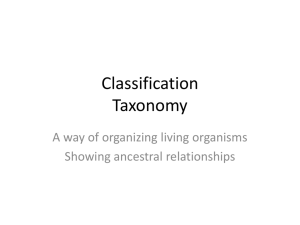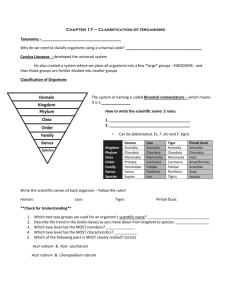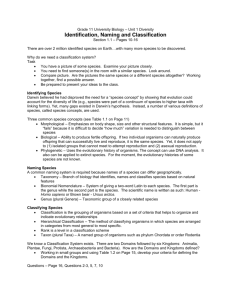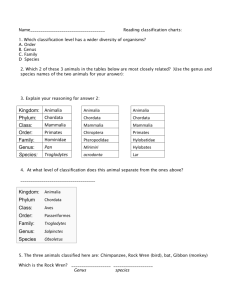Taxonomy, Clades, Classification 10-8
advertisement
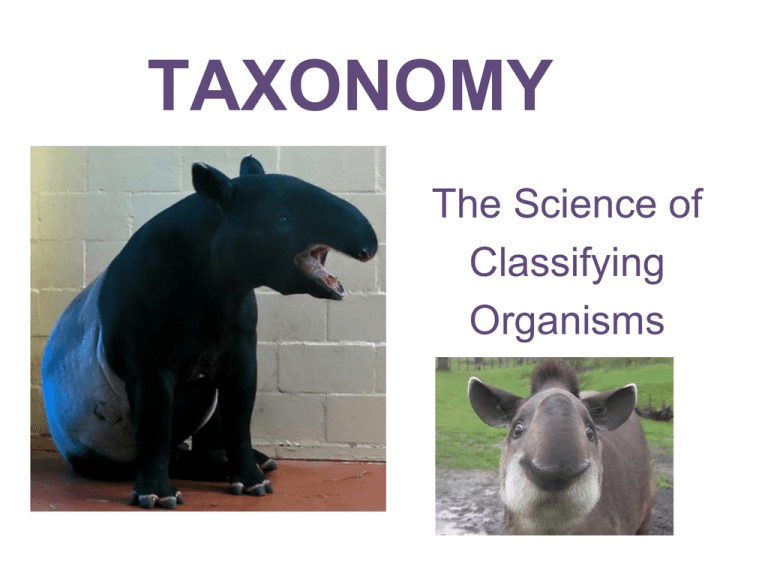
TAXONOMY The Science of Classifying Organisms Why do we need to classify? When you have a lot of information, it is best to organize and group items so that you can find them easier or easily see their relationship to other items ….this is why we CLASSIFY Scientists also need a way to *NAME* organisms •The “common names” used by people can sometimes be misleading or confusing •In order to communicate effectively, biologists need a CONSISTENT naming protocol. Photo Credits Sea Lion: Bill Lim Ant Lion: Amphioxus Lion: law_keven Sea Lion? Antlion? Lion? Which one of these is NOT actually a Photo Credits bear? Panda: Chi King Koala: Belgianchocolate Consider this……….. •Are all “Grey Wolves” gray? •Are all “Black Bears” black? •Which is more venomous – a water moccasin or a cottonmouth? Grey wolves can be white, black and any shade of gray. Black bears can also be brown or gray A cottonmouth and a water moccasin are the same animal – the names vary by region. Naming and Organizing are part of the same process •The system was developed by Carolus Linnaeus who used Greek and Latin names for organisms •He also created a system where we place all organisms into a few *large* groups KINGDOMS - and then those groups are further divided into smaller groups Grouping •Kingdom •Phylum •Class •Order •Family •Genus •Species Each group gets smaller and more specific – just think of the way you file things on your computer into folders and subfolders To help you remember the list KING PHILIP CAME OVER FOR GREAT SOUP Humans Kingdom Animalia Phylum Chordata Class Mammalia Order Primate Family Hominidae Genus Homo Species sapiens The scientific name is always the genus + species Humans = Homo sapiens Lion Tiger Pintail Duck Kingdom Animalia Animalia Animalia Phylum Chordata Chordata Chordata Class Mammalia Mammalia Aves Order Carnivora Carnivora Anseriformes Family Felidae Felidae Anatidae Genus Panthera Panthera Anas Species Leo Tigris acouta What are the scientific names of each of these organisms? More on Naming.. •The system of naming is called BINOMIAL NOMENCLATURE - which means it is a 2name system. •Scientific names must either be underlined or italicized •The genus is always capitalized, the species is lowercase •Can be abbreviated. Ex. F. leo and F. tigris Check for Understanding 1. Fill in the blanks: Kingdom, _____________, Class, Order, ________________, Genus, _______________ 2. Which two groups are used for an organism's scientific name? 3. Which of the following pairs is MOST closely related? Acer rubrum & Acer saccharum Acer rubrum & Chenopodium rubrum 4. The system we use for naming is called ____________ nomenclature. 5. The science of classification is called ________________ Evolutionary Classification •Phylogeny = the study of evolutionary • relationships Biologists now group organisms into categories that represent evolutionary descent (and not just physical similarities) How would you classify a hyena? Would you group it with cats or dogs? Photo credit flickr: ibeatty Derived Characters Characteristics that appear more recently in a group but are not seen in older organisms Derived characters are used to construct a CLADOGRAM • a diagram that shows evolutionary relationships Cladograms A diagram that shows evolutionary relationships Identifying Unknown Organisms •When biologists do field studies, they often encounter new specimens that they would need to identify •FIELD GUIDES often contain pictures for referencing organisms Dichotomous Keys •A step-by-step • What am I?? guide to help identify an organism Follows a series of choices that lead you to the organism’s name Photo Credit: Sam? (Flickr) 1. Has green colored body ......go to 2 Has purple colored body ..... go to 4 2. Has 4 legs .....go to 3 Has 8 legs .......... Deerus octagis 3. Has a tail ........ Deerus pestis Does not have a tail ..... Deerus magnus 4. Has a pointy hump ...... Deerus humpisDoes not have a pointy hump.....go to 5 5. Has ears .........Deerus purplinis Does not have ears ......Deerus deafus Key for Vertebrate Identification What am I ??? 1. a) animal has a spine…………………..go to 2 b) animal has no spine………..…invertebrate 2. a) animal has no gills and fins……..…. go to 3 b) animal has gills and fins…………….. Fish 3. a) animal has no scales…………..........go to 4 b) animal has scales………………..….reptile 4. a) animal has feathers …………………..bird b) animal has no feathers ……………..go to 5 5. a) animal has hair…………………….mammal b) animal has no hair………………..amphibian Check for Understanding •A diagram that shows an evolutionary relationship is a ________________________ •A characteristic that appears only in recent members is called a ________________ character •The study of evolutionary relationships is called __________________________ •A system to find the name of an unknown organism is a
